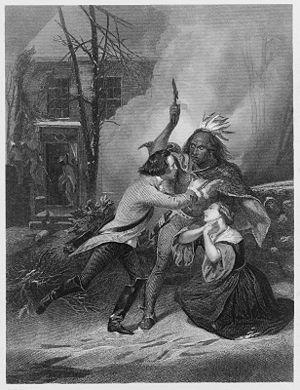
Back Cherry Valley veresaun ET Massacre de Cherry Valley French チェリーバレー虐殺 Japanese Massakren i Cherry Valley NB Резня в Черри-Валли Russian Cherry Valley massacre SIMPLE
| Cherry Valley massacre | |||||||
|---|---|---|---|---|---|---|---|
| Part of the American Revolutionary War | |||||||
 19th century depiction of the murder of Jane Wells | |||||||
| |||||||
| Belligerents | |||||||
|
| |||||||
| Commanders and leaders | |||||||
|
Ichabod Alden † William Stacy (POW) | |||||||
| Strength | |||||||
|
| ||||||
| Casualties and losses | |||||||
|
14 killed 11 captured | 5 wounded | ||||||
|
30 inhabitants killed 30 inhabitants taken into captivity | |||||||
The Cherry Valley massacre was an attack by British and Iroquois forces on a fort and the town of Cherry Valley in central New York on November 11, 1778, during the American Revolutionary War. It has been described as one of the most horrific frontier massacres of the war.[1] A mixed force of Loyalists, British soldiers, Senecas, and Mohawks descended on Cherry Valley, whose defenders, despite warnings, were unprepared for the attack. During the raid, the Seneca in particular targeted non-combatants, and reports state that 30 such individuals were killed, in addition to a number of armed defenders.
The raiders were under the overall command of Walter Butler. However, he had only tenuous authority, at best, over the Indian warriors on the expedition. Historian Barbara Graymont describes Butler's command of the expedition as "criminally incompetent".[2] The Seneca were angered by accusations that they had committed atrocities at the Battle of Wyoming, and the colonists' recent destruction of their forward bases of operation at Unadilla, Onaquaga, and Tioga. Butler's authority with the Indigenous People was undermined by his poor treatment of Joseph Brant, the leader of the Mohawks. Butler repeatedly maintained that he was powerless to restrain the Seneca, despite accusations that he permitted the atrocities to take place.
During the campaigns of 1778, Brant achieved an undeserved reputation for brutality. He was not present at Wyoming — although many thought he was — and he along with Captain Jacob (Scott) of the Saponi (Catawba) actively sought to minimize the atrocities that took place at Cherry Valley. Given that Butler was the overall commander of the expedition, there is controversy as to who actually ordered or failed to restrain the killings.[3] The massacre contributed to calls for reprisals, leading to the 1779 Sullivan Expedition which saw the total military defeat of the British-allied Iroquois in Upstate New York.
- ^ Murray, p. 64
- ^ Cite error: The named reference
Graymont186was invoked but never defined (see the help page). - ^ Mikaberidze, Alexander (June 25, 2013). "Atrocities, Massacres, and War Crimes: An Encyclopedia [2 volumes]: An Encyclopedia". ABC-CLIO. Retrieved July 22, 2017.
Though persuaded to remain, Brant exercised no authority over the raid (nor the regiment).